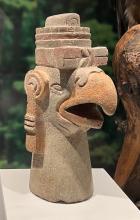cuauhtli (Mdz24v)
This simplex glyph for cuauhtli, eagle, stands for the place name, Cuauhtlan. It is just the head of an eagle, in profile, looking to our right. The beak is slightly open, and a red tongue is visible inside the beak. The beak is yellow toward the head and black on the tip. The eye is yellow, too. The feathers on the head stand out. They are painted two-tone brown and black, and they are textured.
Stephanie Wood
Sometimes this glyph is a whole bird, not just a head. It is worth noting that the cuauhtli was also a calendrical symbol and it had an association with warrior culture, although it is not clear that either of these is the meaning in the context of the place name in this example.
Stephanie Wood
c. 1541, but by 1553 at the latest
Stephanie Wood
eagles, birds, ave, aves, pájaro, pájaros, pluma, plumas, animals, animales
cuauhtli. Described by the Museo del Templo Mayor as a golden eagle head. It was "found in one of the offerings in the southern Red Temple, a building adjacent to the Templo Mayor.... The bird..wears insignia that consisted of disks with hanging strips, as well as a crest tied with white and red bands that identify it with Macuilxochitl-Xochipilli, who was the Sun at dawn, patron of the nobility and lords, deity of flowers, music, games, and dance." Photograph by Robert Haskett, 15 February 2023.

cuauh(tli), eagle, https://nahuatl.wired-humanities.org/content/cuauhtli
Codex Mendoza, folio 24 verso, https://digital.bodleian.ox.ac.uk/objects/2fea788e-2aa2-4f08-b6d9-648c00..., image 59 of 188.
The Bodleian Libraries, University of Oxford, hold the original manuscript, the MS. Arch. Selden. A. 1. This image is published here under the UK Creative Commons, “Attribution-NonCommercial-ShareAlike 3.0 License” (CC-BY-NC-SA 3.0).



